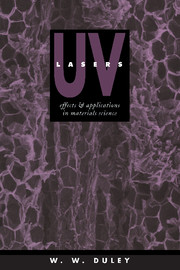Book contents
- Frontmatter
- Contents
- Preface
- Acknowledgments
- 1 Short wavelength lasers
- 2 Optical properties of materials at UV wavelengths
- 3 Photochemical and photothermal effects
- 4 Interaction of UV laser radiation with metals
- 5 Interaction of UV radiation with organic polymers
- 6 Interactions and material removal in inorganic insulators
- 7 UV laser preparation and etching of superconductors
- 8 Interactions and effects in semiconductors
- 9 Laser deposition
- Index
8 - Interactions and effects in semiconductors
Published online by Cambridge University Press: 16 November 2009
- Frontmatter
- Contents
- Preface
- Acknowledgments
- 1 Short wavelength lasers
- 2 Optical properties of materials at UV wavelengths
- 3 Photochemical and photothermal effects
- 4 Interaction of UV laser radiation with metals
- 5 Interaction of UV radiation with organic polymers
- 6 Interactions and material removal in inorganic insulators
- 7 UV laser preparation and etching of superconductors
- 8 Interactions and effects in semiconductors
- 9 Laser deposition
- Index
Summary
LASER SPUTTERING
Direct removal of semiconductor material by laser light without a reactive intermediary has been reported for a number of solids (see reviews by Bäuerle 1986 and Ashby 1991). Direct ablation of small quantities of semiconductor material using UV laser radiation has specific applications in link breaking for circuit restructuring (Smith et al. 1981, Raffel et al. 1985). However, the majority of ablation studies have been carried out in a reactive atmosphere or medium.
A summary of work carried out on the direct ablation or photosublimation of semiconductor materials is given in Table 8.1. In general ablative effects are limited to excitation with high intensity pulses whereas photosublimation occurs by exposure of a semiconductor to CW, visible laser radiation at somewhat lower intensity. Figure 8.1 shows the intensity threshold for ablation in several semiconductors.
Early experiments on the ablation of Si at 193 and 248 nm (Shinn et al. 1986) showed that neither the ablation rate nor the ablation threshold fluence were strongly dependent on laser wavelength, for excitation in this wavelength range. Above the threshold fluence the etching rate was found to be 0.2–0.5 μm per pulse at intensities of 107–108 W cm–2. The threshold fluence was about 1.3Jcm–2 both at 193 and at 248 nm and was found to be independent of ambient gas pressure for pressures between 0–1000 Torr. A strong plasma emission showing a wide variety of Si, Si+ and Si2+ spectral lines was observed at the highest intensities used (about 108 W cm–2).
- Type
- Chapter
- Information
- UV LasersEffects and Applications in Materials Science, pp. 308 - 356Publisher: Cambridge University PressPrint publication year: 1996



